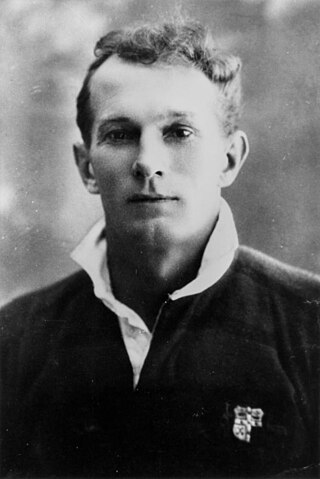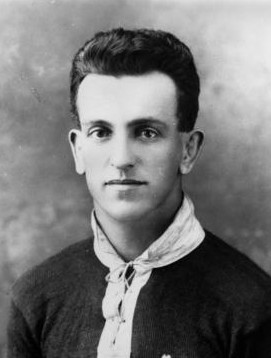
The Australian national rugby league team, the Kangaroos, have represented Australia in senior men's rugby league football competitions since the establishment of the game in Australia in 1908. Administered by the Australian Rugby League Commission, the Kangaroos are ranked first in the IRL Men's World Rankings. The team is the most successful in Rugby League World Cup history, having won the competition 12 times, and contested 15 of the 16 finals, only failing to reach the final in the 1954 inaugural tournament. Only five nations have beaten Australia in test matches, and Australia has an overall win percentage of 69%.

Herbert Walt Steinohrt was an Australian rugby league footballer who played in the 1920s and 1930s as a front row forward for the Australian national team. He played in 9 Tests between 1928 and 1932 as captain on 3 occasions. He has been widely regarded as one of the greatest forwards in rugby league history, being named in the "Queensland Rugby League's Team of the Century", Australian rugby league's 100 greatest players and Toowoomba and South West Team of the Century. Steinohrt was terrific on and off the field, he never lost his temper and was a smart tactician who never played the same game twice. The Valleys Roosters in the Toowoomba Rugby League Competition home ground is named Herb Stenohrt Oval in his honour.
Steve Walters, also known by the nickname of "Boxhead", is an Australian former professional rugby league footballer who played in the 1980s and 1990s who at the peak of his career was considered the best hooker in the game. An Australian Kangaroos and Queensland Maroons representative, he played in the Canberra Raiders' 1st, 2nd and 3rd NSWRL grand final victories.
Les Boyd is an Australian former rugby league footballer who played in the 1970s and 1980s. He played representative football for the Australian national side in international matches as well as the New South Wales side in the State of Origin. Boyd played club football in both Australia and England and his usual position was in the second-row.
Wilhelm Gustaf "Bill" Heidke (1883–1959) was a pioneer Australian rugby league player. He was a backline player for the Australian national team. He played in four Tests between 1908 and 1910, once as captain.
Duncan Hall was an Australian rugby league footballer who played in the 1940s and 1950s, singled out as having been amongst the greatest of the 20th century. He played in the Brisbane Rugby League premiership for Fortitude Valley Diehards and represented Queensland and Australia. He has been named amongst the nation's finest footballers of the 20th century. Away from football Hall worked as a hotelier and bookmaker, and in his later years worked at the Broncos Leagues Club. His son Duncan Hall, Jr. played 15 rugby union tests for the Wallabies

Duncan Fulton Thompson MBE was an Australian veteran of both WWI and WWII and a rugby league footballer, coach and administrator. He was wounded on active service in WWI and has been named amongst the nation's finest footballers of the 20th century, and is regarded as the father of modern coaching. He was appointed a Member of the Order of the British Empire (MBE) in the 1960 New Year Honours "for services to the community in the field of Sport."
Martin Hodgson was an English rugby league footballer who played in the 1920s, 1930s and 1940s. Lauded as one of the game's greatest ever second-rows, he represented Great Britain, England and Cumberland on many occasions. Hodgson played his entire club career with Swinton with whom he won two Championships. He toured Australasia in 1932 and 1936 with the Great Britain lions, and became the only British forward to appear in five Ashes-winning squads, between 1929 and 1937.

Louis Victor Armbruster was an Australian rugby league footballer for New South Wales, Queensland and Australia. He is considered one of the nation's finest footballers of the 20th century. Standing 6 feet 1 inches tall (1.85m) and weighing 191 lbs (86 kg), Armbruster primarily played in the Second-row, but he could also play Lock.

Dan Dempsey was an Australian rugby league national and Queensland state representative player. He played as a hooker and is considered one of the nation's finest footballers of the 20th century.

The 1908–09 Kangaroo tour of Great Britain was the first ever such tour for the newly-formed Australia national rugby league team. The tour was to England and Wales and coincided with the first Wallabies Rugby Union tour of Great Britain, which in hindsight put the Kangaroos in a tough position. The game of rugby league was not yet twelve months old in Australia however a New Zealand side had already toured to Britain, Australia had encountered New Zealand during the 1908 season and the pioneer Australian leaders of the game were keen to match up against the Northern Union founders of the code.
Dud Beattie was an Australian rugby league footballer who played in the 1950s and 1960s. An Australian international and Queensland representative prop forward, he played in Ipswich, Queensland for the Railways club.

Jim Bennett was an Australian rugby league footballer who played in the 1910s, 1920s and 1930s who played for the Australian national team. A Queensland state representative front-row forward, he played his entire career for clubs in Queensland, and was one of the state's early star players, making thirty-six appearances for the Maroons between 1921 and 1930.
Ken Day (1936–1998), also known by the nickname of "High Tower", was an Australian professional rugby league footballer who played in the 1960s. An Australian international and Queensland representative forward, he played his club football in Brisbane for Western Suburbs and in Sydney for Manly-Warringah.
Bill Pearson is an Australian former professional rugby league footballer who played in the 1950s and 1960s. A Queensland interstate representative centre, he played club football in Ipswich, Brisbane and Bundaberg, usually at five-eighth.
Dugald "Doug" McGregor (1890-1948) was a pioneering rugby league footballer who played in the 1900s and 1910s from Queensland. An Australia national representative fullback, he also played for both the Queensland and New South Wales teams.
The 1920 Great Britain Lions tour was the third British national rugby league team or 'Lions' tour of Australasia, where it was winter and matches were played against the Australian and New Zealand national sides, as well as several local teams. In Australia, the three-Test match series was won by the hosts. In New Zealand another three-Test series was played and won by the visitors. The tour was a success and brought in a handsome profit.
The 1933–34 Kangaroo tour of Great Britain was the fifth Kangaroo tour, and took the Australia national rugby league team around the north of England, to London and Paris. The tour also featured the 11th Ashes series which comprised three Test matches and was the first to be won by Great Britain in a clean sweep. The squad's outbound journey was marred by tragedy when Sydney University centre Ray Morris contracted meningitis en route and died in hospital. The tour match played at Stade Pershing in Paris on New Year's Day 1934 was the first rugby league international played in France.
“The Queensland Amateur Rugby League set the air-filled sphere rolling”, opening the competition rounds on 14 May. Three grade competitions were conducted in Brisbane. Ipswich entered a representative team to play the five Brisbane senior teams and also began their own club competition. Club-level rugby league was also played in Maryborough.
Michael Patrick Bolewski was a pioneering Australian international representative rugby league footballer who played in the 1900s and 1910s. He, along with his three brothers, Henry, Alec and Walter, became a pioneering Queensland representative player as well.






